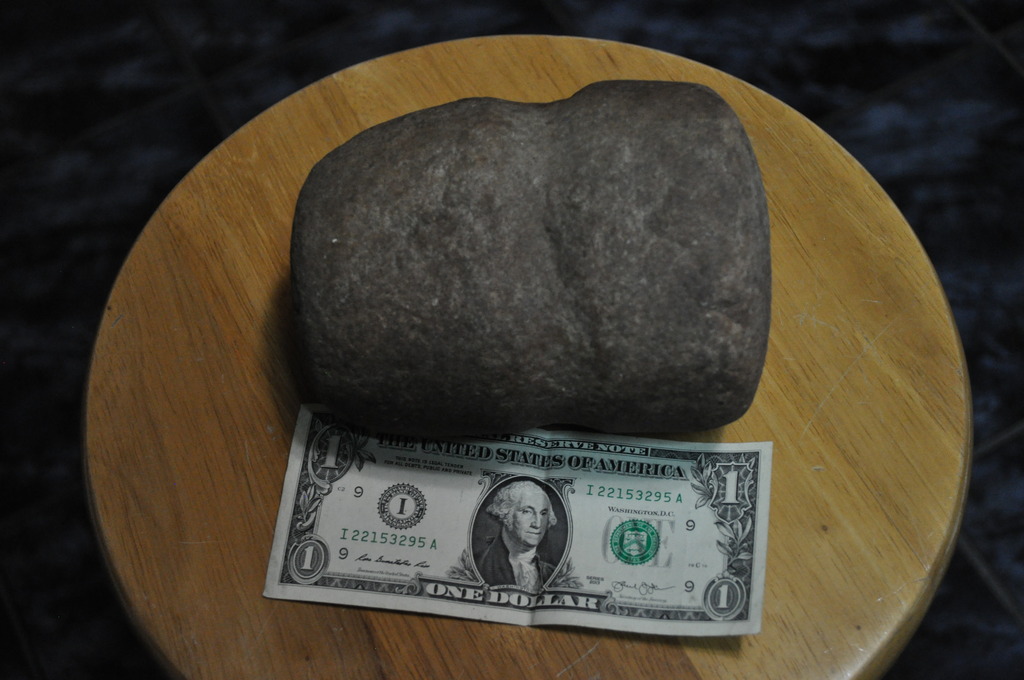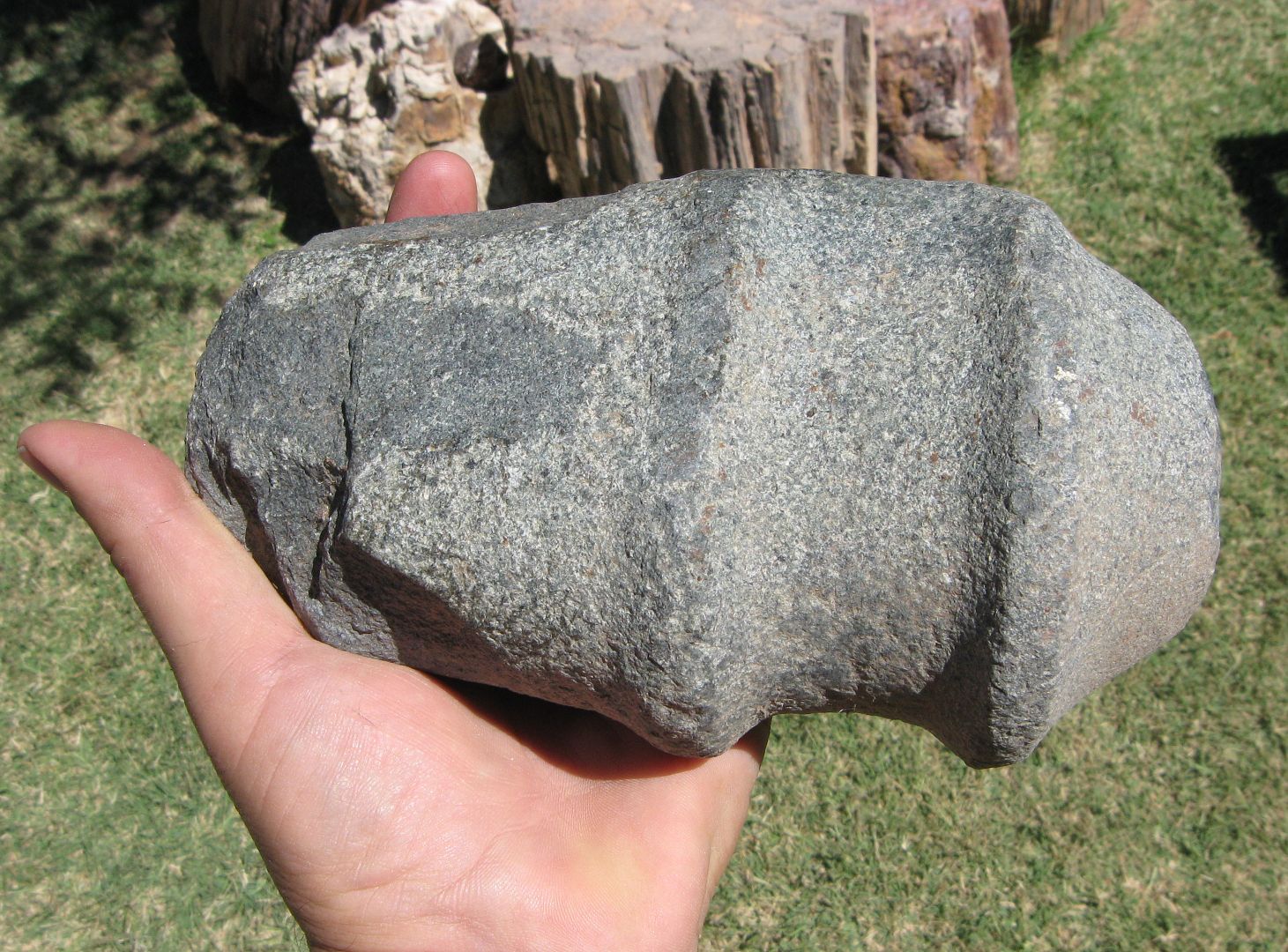|
|
Post by toiv0 on Apr 25, 2017 11:42:25 GMT -5
How in the heck was this piece rigged?   |
|
Fossilman
Cave Dweller 
Member since January 2009
Posts: 20,718 
|
Post by Fossilman on Apr 25, 2017 12:18:25 GMT -5
It was rigged with a hardwood and deer gut.....Hell of a weapon... Found one myself while fossil hounding in Montana...
|
|
Fossilman
Cave Dweller 
Member since January 2009
Posts: 20,718 
|
Post by Fossilman on Apr 25, 2017 12:22:47 GMT -5
|
|
|
|
Post by wigglinrocks on Apr 25, 2017 12:42:14 GMT -5
I have one of those around here somewhere . The one I have is a smoother stone . Take a real man ( or woman ) to swing that thing .
|
|
|
|
Post by nowyo on Apr 25, 2017 19:26:01 GMT -5
Cool find.
Russ
|
|
|
|
Post by toiv0 on Apr 25, 2017 21:12:54 GMT -5
Yah I'm not sure if its a war club or they used it for a sledge. It is made out of granite and showes some wear on the ends. I was going to make a handle for it but its such a beast.
|
|
jamesp
Cave Dweller 
Member since October 2012
Posts: 36,600
|
Post by jamesp on Apr 25, 2017 21:18:17 GMT -5
A bad day for a man to run into an angry native fellow with a long handled tomahawk with that 1 pound stone tied to the end. Hopefully he was packing that day.  Consider an Osage Orange bow. They crafted these to follow every fiber in the wood tip to tip. Note how bends follow grain in front and sides. Every fiber intact. By splitting along the grain. For maximum fiber usage. Same technology as carbon fiber or fiberglass. Wood instead. Strong wood. Those bows can have over 100 pounds pull. Easy to kill a deer with. Early American's were not to fond of these weapons. Target practice probably began at 5 years of age. And food depended on accuracy. Other than taper, only on the back side of the bow were grains cut, at the fat spot for the arrow rest. The tension side is the front, those fibers are maintained end to end(other than taper). Brilliant and deadly  |
|
|
|
Post by toiv0 on Apr 25, 2017 23:01:42 GMT -5
A bad day for a man to run into an angry native fellow with a long handled tomahawk with that 1 pound stone tied to the end. Hopefully he was packing that day.  Consider an Osage Orange bow. They crafted these to follow every fiber in the wood tip to tip. Note how bends follow grain in front and sides. Every fiber intact. By splitting along the grain. For maximum fiber usage. Same technology as carbon fiber or fiberglass. Wood instead. Strong wood. Those bows can have over 100 pounds pull. Easy to kill a deer with. Early American's were not to fond of these weapons. Target practice probably began at 5 years of age. And food depended on accuracy. Other than taper, only on the back side of the bow were grains cut, at the fat spot for the arrow rest. The tension side is the front, those fibers are maintained end to end(other than taper). Brilliant and deadly  Alot of trial and error I bet, I can hear it but in indian awwwwwwwww sh&t |
|
|
|
Post by wigglinrocks on Apr 25, 2017 23:56:17 GMT -5
How in the heck was this piece rigged?   Dug out my beater , I think mine is quartzite .  |
|
|
|
Post by toiv0 on Apr 26, 2017 5:39:53 GMT -5
How in the heck was this piece rigged? Dug out my beater , I think mine is quartzite .  Looks about the same size, gives me a headache just looking at them. |
|
|
|
Post by wigglinrocks on Apr 26, 2017 9:42:16 GMT -5
Dug out my beater , I think mine is quartzite .  Looks about the same size, gives me a headache just looking at them. I think they must have been used for pounding on things other than heads . Just hauling it around for awhile would be a workout . |
|
Fossilman
Cave Dweller 
Member since January 2009
Posts: 20,718 
|
Post by Fossilman on Apr 26, 2017 9:49:02 GMT -5
That Osage Orange wood is sure some nice looking material,a buddy of mine sent me a few pieces of it from Ohio...
|
|
Fossilman
Cave Dweller 
Member since January 2009
Posts: 20,718 
|
Post by Fossilman on Apr 26, 2017 9:56:45 GMT -5
Here is mine....Found in Montana (Central area),while fossil hounding...I know this club was carried in,because this type of material,doesn't exist in that area....   |
|
|
|
Post by wigglinrocks on Apr 26, 2017 10:12:59 GMT -5
Here is mine....Found in Montana (Central area),while fossil hounding...I know this club was carried in,because this type of material,doesn't exist in that area....   What kind of rock is that ? Looks similar to mine , seems like mine was found in Montana but not sure . |
|
|
|
Post by youp50 on Apr 29, 2017 4:56:08 GMT -5
They were common in the Rockland/Greenland district. I have seen some large ones with two rings, double handles. The ancient people mined the copper with them, fire and water. There is a documented spring lined with them. Early (mid 1800s) prospectors found that their pits, filled in by centuries of forest duff, were great places to start mining copper. The 'Native Michigan' copper was lying exposed. The same veins that provided the float copper for the glaciers to move into Wisconsin. Its uncommon to find them in good shape like yours. They are chipped and beat up. I suspect there were a lot of one eyed ancients.
It is thought the ancient miners were the same people as the mound builders in Wisconsin. The mounds built in the copper district were fortification mounds, the mounds in Wisconsin were thought to be more of a religious thing. Sun worshipers, at least there is archaeological evidence they tracked the sun.
Most of hammerheads around the copper district were a hard, dark porphyry.
Stone age people, making jewelry and implements of copper. Now we have space age artisans, making jewelry and implements out of copper...
|
|
|
|
Post by wigglinrocks on Apr 29, 2017 9:16:54 GMT -5
They were common in the Rockland/Greenland district. I have seen some large ones with two rings, double handles. The ancient people mined the copper with them, fire and water. There is a documented spring lined with them. Early (mid 1800s) prospectors found that their pits, filled in by centuries of forest duff, were great places to start mining copper. The 'Native Michigan' copper was lying exposed. The same veins that provided the float copper for the glaciers to move into Wisconsin. Its uncommon to find them in good shape like yours. They are chipped and beat up. I suspect there were a lot of one eyed ancients. It is thought the ancient miners were the same people as the mound builders in Wisconsin. The mounds built in the copper district were fortification mounds, the mounds in Wisconsin were thought to be more of a religious thing. Sun worshipers, at least there is archaeological evidence they tracked the sun. Most of hammerheads around the copper district were a hard, dark porphyry. Stone age people, making jewelry and implements of copper. Now we have space age artisans, making jewelry and implements out of copper... Wasn't the Ontonagon boulder found in one of those ancient mine pits ? |
|
|
|
Post by youp50 on Apr 29, 2017 12:30:27 GMT -5
Actually the Ontonagon boulder was a piece of float found on the banks of the Ontonagon River. Legend has human sacrifices taking place on it. I think that is hookey. The Ojibwa natives were not big on that kind of stuff. There was a man credited with founding Ontonagon, J.K. Paul that had a rep as a hard drinking kind of a truth stretcher. He irritated one Daniel Cash to where Cash set up on the west bank of the river while Paul was on the east. Cash moved on to a small settlement on the west end of Lake Superior, called it Duluth. He did well there. Paul was credited with getting the boulder down to the river mouth and the Feds accosted it with little regard for his finances. Legend has Paul moving another boulder to the mouth and then sinking it in the Lake, "They ain't taking this one, too."
|
|
|
|
Post by beefjello on Apr 29, 2017 15:12:30 GMT -5
This one would have left a mark  |
|
|
|
Post by wigglinrocks on Apr 29, 2017 20:57:39 GMT -5
Actually the Ontonagon boulder was a piece of float found on the banks of the Ontonagon River. Legend has human sacrifices taking place on it. I think that is hookey. The Ojibwa natives were not big on that kind of stuff. There was a man credited with founding Ontonagon, J.K. Paul that had a rep as a hard drinking kind of a truth stretcher. He irritated one Daniel Cash to where Cash set up on the west bank of the river while Paul was on the east. Cash moved on to a small settlement on the west end of Lake Superior, called it Duluth. He did well there. Paul was credited with getting the boulder down to the river mouth and the Feds accosted it with little regard for his finances. Legend has Paul moving another boulder to the mouth and then sinking it in the Lake, "They ain't taking this one, too." I forget what that chunk weighed , we saw the replica in the museum in Ontonagon . Its a biggun . |
|